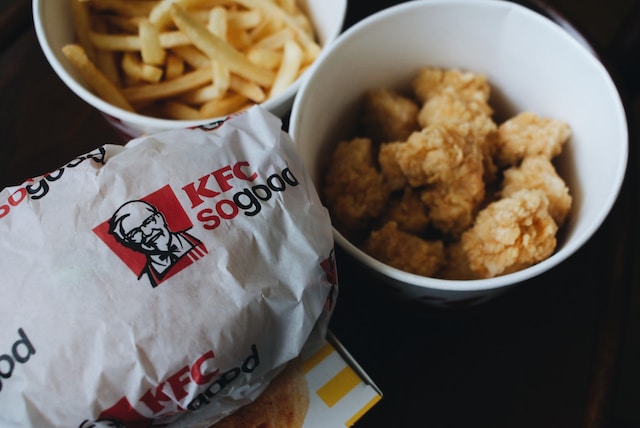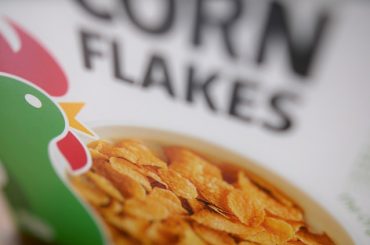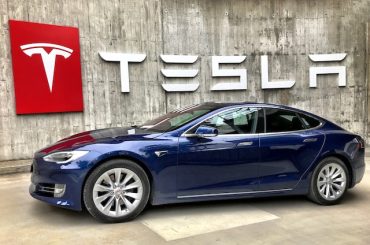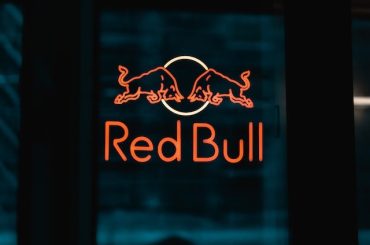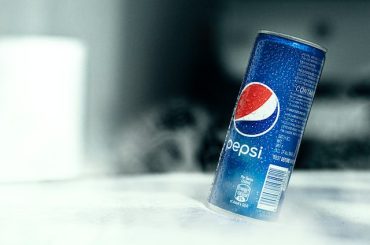Before we dive deep into the Marketing Mix (4Ps), let’s get the business overview of KFC. Kentucky Fried Chicken, or KFC, is a global fast-food chain specializing in fried chicken. Founded by Colonel Harland Sanders in 1952, the company has become one of the world’s most recognizable and successful fast-food brands. Here is a brief overview of KFC’s business:
- Brand & Ownership: KFC is a subsidiary of Yum! Brands, Inc., which also owns other popular fast-food chains like Taco Bell and Pizza Hut. The iconic KFC brand is known for its secret blend of 11 herbs and spices, which is still used in chicken recipes.
- Menu: KFC’s core offering is its fried chicken, which comes in various forms such as Original Recipe, Extra Crispy, and Spicy. The menu also includes sandwiches, wraps, salads, sides, desserts, and beverages. KFC has also expanded its menu to accommodate local tastes in various markets, offering items like rice bowls, chicken curry, and grilled chicken.
- Global Presence: KFC has a strong international presence, with over 24,000 restaurants in over 145 countries. The brand’s most significant markets include the United States, China, Japan, the United Kingdom, and India. KFC continues to expand in both developed and emerging markets.
- Franchise Model: KFC primarily operates on a franchise model, where local entrepreneurs own and operate individual restaurants under the KFC brand. This model enables the company to expand quickly with lower capital investment and allows local operators to adapt the menu and operations to suit regional tastes and preferences.
- Innovation: KFC is committed to innovation, both in its menu and in its business operations. The company has been working on plant-based alternatives to cater to the growing demand for vegetarian and vegan options. In addition, KFC has been investing in digital technology to improve customer experiences, such as through online ordering, mobile payments, and delivery services.
- Corporate Social Responsibility: KFC has made efforts to address environmental and social issues. The company has committed to reducing its environmental footprint through initiatives like sustainable sourcing, energy efficiency, and waste reduction. KFC also engages in community outreach programs and supports various charitable organizations.
- Financial Performance: KFC is a significant contributor to Yum! Brands’ overall revenue and profitability. The brand has experienced steady growth, driven by new restaurant openings and same-store sales growth. YUM’s 2020 annual report shows that KFC generated $26.2 billion in revenue.
Here is the Marketing Mix (4Ps) for KFC
A marketing mix, also known as the 4Ps of marketing, is framework marketers use to develop and implement effective marketing strategies. The concept helps businesses identify and optimize the key components necessary to promote and sell their products or services. The 4Ps of the marketing mix are Product, Price, Place, and Promotion.
In addition to the traditional 4 Ps, marketers have expanded their strategies by incorporating additional elements (People, Process & Performance) to help them better understand and reach their target audiences. But we will focus on the 4Ps as they are the foundation of any marketing strategy. In this article, we will understand the marketing mix (4Ps) of KFC.
What is a Marketing Mix? What are the 4Ps of Marketing?
Product
- Core product: KFC’s core product is its signature fried chicken, known for its unique blend of 11 herbs and spices in the “Original Recipe.” This secret recipe, developed by Colonel Harland Sanders, distinguishes KFC from its competitors and has been the brand’s foundation since its inception.
- Menu variety: In addition to the Original Recipe fried chicken, KFC offers a variety of other menu items to cater to diverse customer preferences. These include grilled and crispy chicken options, chicken sandwiches, wraps, salads, side dishes like mashed potatoes, coleslaw, biscuits, and desserts and beverages.
- Limited-time offers (LTOs) and regional items: KFC regularly introduces limited-time offers and seasonal promotions to keep its menu fresh and appealing. Additionally, the company adapts its menu to cater to local tastes and preferences in different markets worldwide. For example, KFC may offer rice bowls or curry dishes in Asian markets, while in the Middle East, it may provide options like the “Zinger” spicy chicken sandwich.
- Focus on quality and taste: KFC emphasizes the quality of its ingredients and the taste of its products. The brand consistently enhances its recipes and cooking processes to ensure customers receive the best possible taste experience.
- Innovation: KFC is known for experimenting with new products and flavors to maintain customer interest and stay ahead of market trends. Examples include introducing plant-based options like “Beyond Fried Chicken” and unique creations such as the “Double Down” sandwich, which replaces the traditional bun with two pieces of fried chicken.
Price
- Competitive pricing: KFC’s prices are generally set in line with its direct competitors in the fast-food industry, such as McDonald’s, Burger King, and other quick-service restaurants. By offering competitive prices, KFC aims to attract a broad customer base without sacrificing its image as a provider of high-quality food products.
- Value for money: KFC focuses on providing value for money to its customers by offering a variety of meal options at different price points. This includes individual items, combo meals, and family-sized meal deals, allowing customers to choose according to their preferences and budget. KFC’s value proposition is centered around delivering tasty, high-quality food at affordable prices.
- Price bundling: KFC often utilizes price bundling strategies, combining multiple items into a meal deal and offering a discount compared to purchasing the items separately. This approach encourages customers to buy more items and increases the overall revenue per transaction. Examples of bundled offerings include the “Bucket Meals” and “Box Meals.”
- Dynamic pricing and promotions: KFC regularly employs promotional pricing strategies to attract new customers and encourage repeat visits from existing ones. These may include limited-time offers, seasonal discounts, or special promotions tied to events or holidays. Such promotions can help drive foot traffic, boost sales, and maintain customer interest in the brand.
- Geographic pricing variations: KFC adjusts its prices based on different markets’ cost structures and economic conditions. This means that prices may vary across countries and even within regions of the same country, considering factors such as local competition, cost of living, taxes, and purchasing power.
Place
- Physical locations: KFC operates thousands of restaurants across the globe, with a strong presence in both urban and suburban areas. The company strategically selects locations that maximize visibility and foot traffic, such as shopping malls, city centers, transportation hubs, and busy commercial districts. This extensive network of outlets helps KFC reach a wide customer base and increase its market share.
- Franchise model: KFC primarily operates through a franchise model, which allows it to rapidly expand its presence in various markets while sharing risks and responsibilities with local franchisees. This model also enables KFC to benefit from local market knowledge and adapt its operations to suit regional preferences and regulations.
- Drive-thru and delivery services: To cater to customers’ evolving tastes and lifestyles, KFC offers drive-thru services at many locations, allowing customers to conveniently pick up their orders without leaving their cars. Furthermore, the company has invested in expanding its delivery services, partnering with third-party platforms, and developing its online ordering systems to make its products more accessible.
- Digital presence: KFC leverages digital channels like its website and mobile apps to provide a seamless customer experience. These platforms allow customers to browse the menu, place orders for pickup or delivery, and access promotional offers. By embracing digital technology, KFC can enhance customer engagement and drive sales.
- Local market adaptation: KFC tailors its operations and offerings to suit local market conditions and preferences. This may involve adjusting store designs, menu items, and service styles to resonate with local customers. Such adaptations help KFC maintain its appeal and relevance in diverse markets worldwide.
Promotion
- Advertising: KFC invests in advertising through various channels, such as television, radio, print, outdoor billboards, and digital platforms. The company creates engaging ads that showcase its products and highlight its unique selling points, such as the secret blend of 11 herbs and spices or its commitment to quality and taste.
- Digital and social media marketing: KFC maintains a strong presence on social media platforms like Facebook, Instagram, Twitter, and YouTube, sharing engaging content, promotional offers, and news about its products and initiatives. By leveraging social media, KFC can directly interact with its customers, gather feedback, and create a sense of community around its brand.
- Public relations and events: KFC engages in public relations activities to maintain a positive brand image and generate media coverage. This may include sponsoring events, participating in community initiatives, or collaborating with influencers and celebrities. Such efforts help KFC build goodwill and raise its brand profile.
- Limited-time offers and promotions: KFC frequently introduces limited-time offers and promotions to create excitement around its products and encourage customer visits. These can include seasonal menu items, special discounts, or tie-ins with popular events or holidays. Limited-time promotions help KFC maintain customer interest and drive sales.
- Loyalty programs and customer incentives: KFC offers loyalty programs and customer incentives to reward repeat customers and foster brand loyalty. For example, KFC may provide exclusive deals, discounts, or free items to customers who join its loyalty program or download its mobile app. These incentives encourage repeat business and strengthen customer relationships.
- In-store promotions and merchandising: KFC utilizes in-store promotions and merchandising techniques to create an appealing atmosphere and draw attention to its products. This can include eye-catching point-of-sale displays, promotional signage, and product packaging that showcases the brand’s identity and values.

